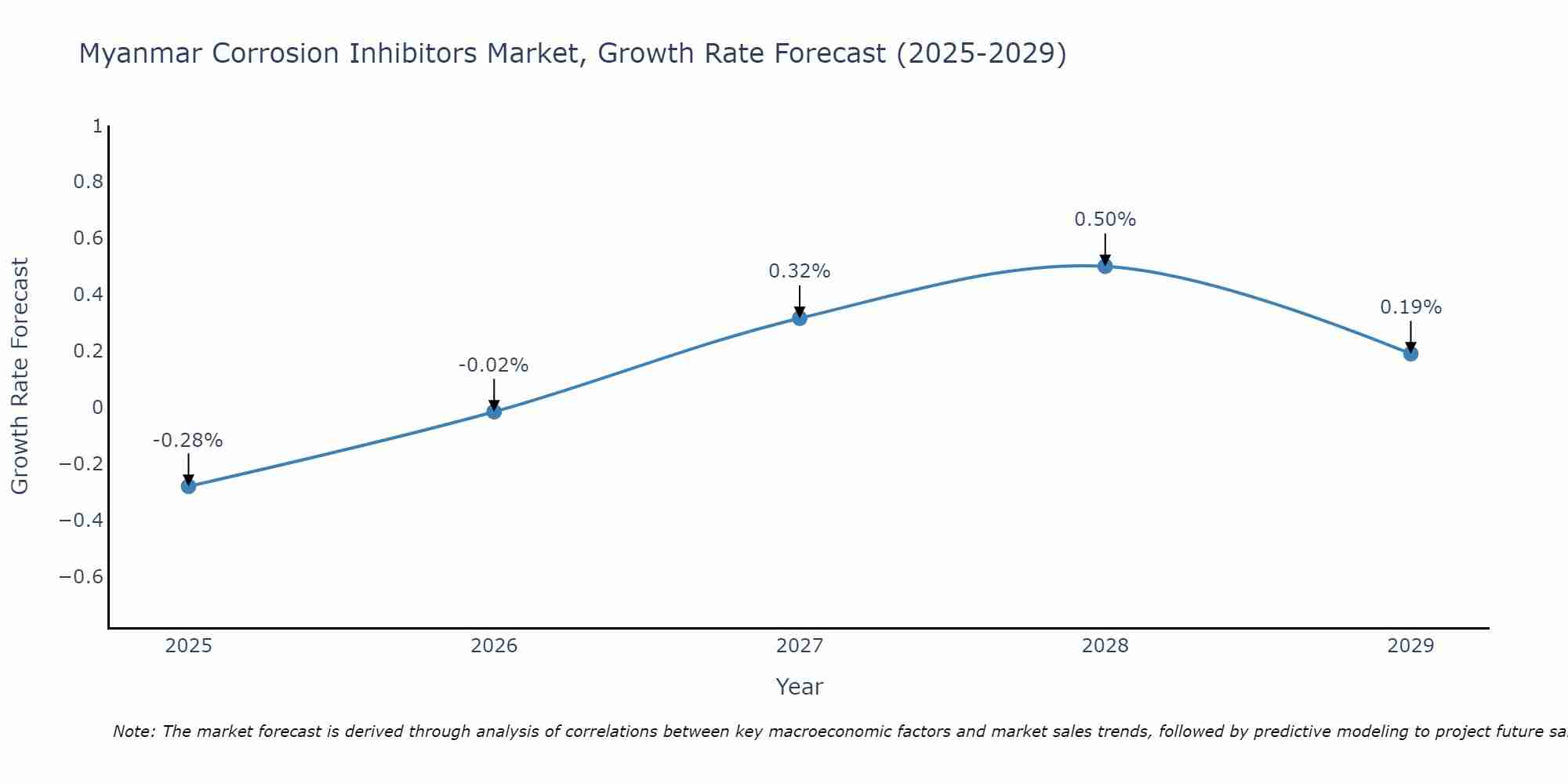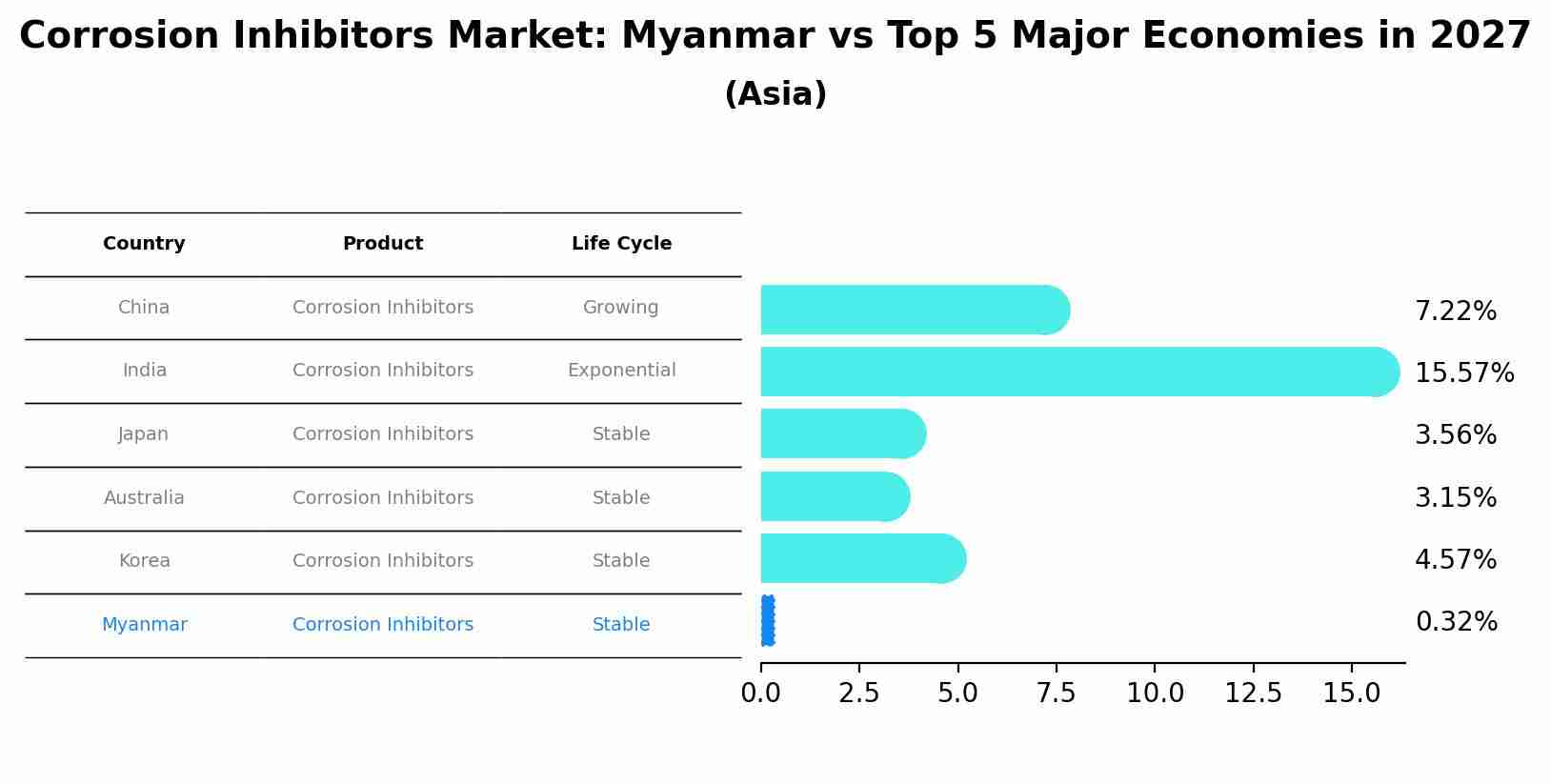Myanmar Corrosion Inhibitors Market (2025-2031) Outlook | Industry, Share, Trends, Growth, Analysis, Revenue, Forecast, Companies, Size & Value
| Product Code: ETC130614 | Publication Date: Jun 2021 | Updated Date: Apr 2025 | Product Type: Report | |
| Publisher: 6Wresearch | Author: Ravi Bhandari | No. of Pages: 70 | No. of Figures: 35 | No. of Tables: 5 |
Myanmar Corrosion Inhibitors Market Size Growth Rate
The Myanmar Corrosion Inhibitors Market is projected to witness mixed growth rate patterns during 2025 to 2029. Growth accelerates to 0.50% in 2028, following an initial rate of -0.28%, before easing to 0.19% at the end of the period.

Corrosion Inhibitors Market: Myanmar vs Top 5 Major Economies in 2027 (Asia)
By 2027, Myanmar's Corrosion Inhibitors market is forecasted to achieve a stable growth rate of 0.32%, with China leading the Asia region, followed by India, Japan, Australia and South Korea.

Myanmar Corrosion Inhibitors Market Overview
With Myanmar industrial growth and infrastructure development, the demand for corrosion inhibitors is increasing. Corrosion inhibitors are substances used to reduce the corrosion rate of metals and alloys exposed to various environments. In sectors such as oil and gas, transportation, and manufacturing, these inhibitors play a crucial role in protecting equipment and structures from degradation.
Drivers of the market
In Myanmar, the Corrosion Inhibitors Market is witnessing significant growth owing to the expanding industrial infrastructure and the need to mitigate the adverse effects of corrosion on metal surfaces. Industries such as oil and gas, petrochemicals, and manufacturing are actively adopting corrosion inhibitors to prolong the lifespan of equipment, reduce maintenance costs, and ensure operational safety. Additionally, stringent environmental regulations and the increasing awareness about the importance of corrosion prevention are driving the demand for environmentally friendly inhibitor formulations, thereby propelling market growth.
Challenges of the market
The Corrosion Inhibitors market in Myanmar encounters obstacles such as inadequate awareness among industries about the importance of corrosion prevention, leading to underinvestment in protective measures. Moreover, the availability of low-cost but less effective inhibitors poses a challenge to the market`s growth, as companies may prioritize short-term cost savings over long-term corrosion protection.
Government Policy of the market
Similarly, the Corrosion Inhibitors market in Myanmar is seeing development supported by government regulations aimed at protecting infrastructure and industrial assets. Policies mandating the use of corrosion inhibitors in key sectors such as oil and gas, transportation, and manufacturing are driving market growth. This is further augmented by the country`s expanding industrial base and infrastructure projects, which necessitate effective corrosion protection measures.
Key Highlights of the Report:
- Myanmar Corrosion Inhibitors Market Outlook
- Market Size of Myanmar Corrosion Inhibitors Market, 2024
- Forecast of Myanmar Corrosion Inhibitors Market, 2031
- Historical Data and Forecast of Myanmar Corrosion Inhibitors Revenues & Volume for the Period 2021-2031
- Myanmar Corrosion Inhibitors Market Trend Evolution
- Myanmar Corrosion Inhibitors Market Drivers and Challenges
- Myanmar Corrosion Inhibitors Price Trends
- Myanmar Corrosion Inhibitors Porter's Five Forces
- Myanmar Corrosion Inhibitors Industry Life Cycle
- Historical Data and Forecast of Myanmar Corrosion Inhibitors Market Revenues & Volume By Product for the Period 2021-2031
- Historical Data and Forecast of Myanmar Corrosion Inhibitors Market Revenues & Volume By Organic for the Period 2021-2031
- Historical Data and Forecast of Myanmar Corrosion Inhibitors Market Revenues & Volume By Inorganic for the Period 2021-2031
- Historical Data and Forecast of Myanmar Corrosion Inhibitors Market Revenues & Volume By Type for the Period 2021-2031
- Historical Data and Forecast of Myanmar Corrosion Inhibitors Market Revenues & Volume By Water Based for the Period 2021-2031
- Historical Data and Forecast of Myanmar Corrosion Inhibitors Market Revenues & Volume By Oil Based for the Period 2021-2031
- Historical Data and Forecast of Myanmar Corrosion Inhibitors Market Revenues & Volume By End-use for the Period 2021-2031
- Historical Data and Forecast of Myanmar Corrosion Inhibitors Market Revenues & Volume By Power Generation for the Period 2021-2031
- Historical Data and Forecast of Myanmar Corrosion Inhibitors Market Revenues & Volume By Oil & Gas for the Period 2021-2031
- Historical Data and Forecast of Myanmar Corrosion Inhibitors Market Revenues & Volume By Paper & Pulp for the Period 2021-2031
- Historical Data and Forecast of Myanmar Corrosion Inhibitors Market Revenues & Volume By Metal Processing for the Period 2021-2031
- Historical Data and Forecast of Myanmar Corrosion Inhibitors Market Revenues & Volume By Chemical Processing for the Period 2021-2031
- Historical Data and Forecast of Myanmar Corrosion Inhibitors Market Revenues & Volume By Water Treatment for the Period 2021-2031
- Historical Data and Forecast of Myanmar Corrosion Inhibitors Market Revenues & Volume By Others for the Period 2021-2031
- Myanmar Corrosion Inhibitors Import Export Trade Statistics
- Market Opportunity Assessment By Product
- Market Opportunity Assessment By Type
- Market Opportunity Assessment By End-use
- Myanmar Corrosion Inhibitors Top Companies Market Share
- Myanmar Corrosion Inhibitors Competitive Benchmarking By Technical and Operational Parameters
- Myanmar Corrosion Inhibitors Company Profiles
- Myanmar Corrosion Inhibitors Key Strategic Recommendations
Frequently Asked Questions About the Market Study (FAQs):
Myanmar Corrosion Inhibitors |
1 Executive Summary |
2 Introduction |
2.1 Key Highlights of the Report |
2.2 Report Description |
2.3 Market Scope & Segmentation |
2.4 Research Methodology |
2.5 Assumptions |
3 Myanmar Corrosion Inhibitors Market Overview |
3.1 Myanmar Country Macro Economic Indicators |
3.2 Myanmar Corrosion Inhibitors Market Revenues & Volume, 2021 & 2031F |
3.3 Myanmar Corrosion Inhibitors Market - Industry Life Cycle |
3.4 Myanmar Corrosion Inhibitors Market - Porter's Five Forces |
3.5 Myanmar Corrosion Inhibitors Market Revenues & Volume Share, By Form, 2021 & 2031F |
3.6 Myanmar Corrosion Inhibitors Market Revenues & Volume Share, By Type, 2021 & 2031F |
3.7 Myanmar Corrosion Inhibitors Market Revenues & Volume Share, By End-use, 2021 & 2031F |
4 Myanmar Corrosion Inhibitors Market Dynamics |
4.1 Impact Analysis |
4.2 Market Drivers |
4.3 Market Restraints |
5 Myanmar Corrosion Inhibitors Market Trends |
6 Myanmar Corrosion Inhibitors Market, By Types |
6.1 Myanmar Corrosion Inhibitors Market, By Product |
6.1.1 Overview and Analysis |
6.1.2 Myanmar Corrosion Inhibitors Market Revenues & Volume, By Product, 2021-2031F |
6.1.3 Myanmar Corrosion Inhibitors Market Revenues & Volume, By Organic, 2021-2031F |
6.1.4 Myanmar Corrosion Inhibitors Market Revenues & Volume, By Inorganic, 2021-2031F |
6.2 Myanmar Corrosion Inhibitors Market, By Type |
6.2.1 Overview and Analysis |
6.2.2 Myanmar Corrosion Inhibitors Market Revenues & Volume, By Water Based, 2021-2031F |
6.2.3 Myanmar Corrosion Inhibitors Market Revenues & Volume, By Oil Based, 2021-2031F |
6.3 Myanmar Corrosion Inhibitors Market, By End-use |
6.3.1 Overview and Analysis |
6.3.2 Myanmar Corrosion Inhibitors Market Revenues & Volume, By Power Generation, 2021-2031F |
6.3.3 Myanmar Corrosion Inhibitors Market Revenues & Volume, By Oil & Gas, 2021-2031F |
6.3.4 Myanmar Corrosion Inhibitors Market Revenues & Volume, By Paper & Pulp, 2021-2031F |
6.3.5 Myanmar Corrosion Inhibitors Market Revenues & Volume, By Metal Processing, 2021-2031F |
6.3.6 Myanmar Corrosion Inhibitors Market Revenues & Volume, By Chemical Processing, 2021-2031F |
6.3.7 Myanmar Corrosion Inhibitors Market Revenues & Volume, By Water Treatment, 2021-2031F |
7 Myanmar Corrosion Inhibitors Market Import-Export Trade Statistics |
7.1 Myanmar Corrosion Inhibitors Market Export to Major Countries |
7.2 Myanmar Corrosion Inhibitors Market Imports from Major Countries |
8 Myanmar Corrosion Inhibitors Market Key Performance Indicators |
9 Myanmar Corrosion Inhibitors Market - Opportunity Assessment |
9.1 Myanmar Corrosion Inhibitors Market Opportunity Assessment, By Product, 2021 & 2031F |
9.2 Myanmar Corrosion Inhibitors Market Opportunity Assessment, By Type, 2021 & 2031F |
9.3 Myanmar Corrosion Inhibitors Market Opportunity Assessment, By End-use, 2021 & 2031F |
10 Myanmar Corrosion Inhibitors Market - Competitive Landscape |
10.1 Myanmar Corrosion Inhibitors Market Revenue Share, By Companies, 2024 |
10.2 Myanmar Corrosion Inhibitors Market Competitive Benchmarking, By Operating and Technical Parameters |
11 Company Profiles |
12 Recommendations |
13 Disclaimer |
- Single User License$ 1,995
- Department License$ 2,400
- Site License$ 3,120
- Global License$ 3,795
Search
Thought Leadership and Analyst Meet
Our Clients
Related Reports
- Afghanistan Apparel Market (2026-2032) | Growth, Outlook, Industry, Segmentation, Forecast, Size, Companies, Trends, Value, Share, Analysis & Revenue
- Canada Oil and Gas Market (2026-2032) | Share, Segmentation, Value, Industry, Trends, Forecast, Analysis, Size & Revenue, Growth, Competitive Landscape, Outlook, Companies
- Germany Breakfast Food Market (2026-2032) | Industry, Share, Growth, Size, Companies, Value, Analysis, Revenue, Trends, Forecast & Outlook
- Australia Briquette Market (2025-2031) | Growth, Size, Revenue, Forecast, Analysis, Trends, Value, Share, Industry & Companies
- Vietnam System Integrator Market (2025-2031) | Size, Companies, Analysis, Industry, Value, Forecast, Growth, Trends, Revenue & Share
- ASEAN and Thailand Brain Health Supplements Market (2025-2031) | Strategy, Consumer Insights, Analysis, Investment Trends, Opportunities, Growth, Size, Share, Industry, Revenue, Segments, Value, Segmentation, Supply, Forecast, Restraints, Outlook, Competition, Drivers, Trends, Demand, Pricing Analysis, Competitive, Strategic Insights, Companies, Challenges
- ASEAN Bearings Market (2025-2031) | Strategy, Consumer Insights, Analysis, Investment Trends, Opportunities, Growth, Size, Share, Industry, Revenue, Segments, Value, Segmentation, Supply, Forecast, Restraints, Outlook, Competition, Drivers, Trends, Demand, Pricing Analysis, Competitive, Strategic Insights, Companies, Challenges
- Europe Flooring Market (2025-2031) | Outlook, Share, Industry, Trends, Forecast, Companies, Revenue, Size, Analysis, Growth & Value
- Saudi Arabia Manlift Market (2025-2031) | Outlook, Size, Growth, Trends, Companies, Industry, Revenue, Value, Share, Forecast & Analysis
- Uganda Excavator, Crane, and Wheel Loaders Market (2025-2031) | Strategy, Consumer Insights, Analysis, Investment Trends, Opportunities, Growth, Size, Share, Industry, Revenue, Segments, Value, Segmentation, Supply, Forecast, Restraints, Outlook, Competition, Drivers, Trends, Demand, Pricing Analysis, Competitive, Strategic Insights, Companies, Challenges
Industry Events and Analyst Meet
Whitepaper
- Middle East & Africa Commercial Security Market Click here to view more.
- Middle East & Africa Fire Safety Systems & Equipment Market Click here to view more.
- GCC Drone Market Click here to view more.
- Middle East Lighting Fixture Market Click here to view more.
- GCC Physical & Perimeter Security Market Click here to view more.
6WResearch In News
- Doha a strategic location for EV manufacturing hub: IPA Qatar
- Demand for luxury TVs surging in the GCC, says Samsung
- Empowering Growth: The Thriving Journey of Bangladesh’s Cable Industry
- Demand for luxury TVs surging in the GCC, says Samsung
- Video call with a traditional healer? Once unthinkable, it’s now common in South Africa
- Intelligent Buildings To Smooth GCC’s Path To Net Zero


















